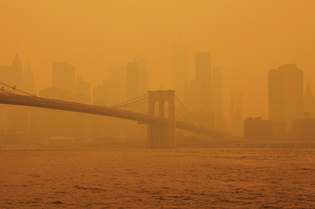
Naoko Takagi/IStock
New York City’s Brooklyn Bridge, shrouded by an amber haze in June 2023 as wildfires blazed in Canada. New research links the spike in poor air quality with a spike in asthma-related visits to emergency rooms.
View full image
Skies glowed the orange of apocalypse. Suspension bridges disappeared in middle distance. People wore their masks not for the virus, but for the smoke. On June 7, 2023, New York City recorded the worst air quality of any major city in the world.
Hundreds of miles away, Canadian fires blazed. “People don’t tend to think about wildfire impacts in New York City, or along the Eastern Seaboard,” says Kai Chen, an assistant professor at the Yale School of Public Health and director of research at the Yale Center on Climate Change and Health. “This year was a reminder that even these places can have very severe smoke.”
New research by Chen and three colleagues at Yale and Columbia linked the smokiest weekend in New York City (June 6–8) with emergency department visits for asthma citywide. They found that on June 7, when air quality was at its worst, there were 261 asthma-related visits to the emergency department—an increase of nearly 50 percent above the average.
For two reasons, Chen notes, the effects of wildfire smoke are even more troubling than this one figure suggests. First, the researchers focused their study on asthma, because it is a straightforward outcome. Particulates from wildfire smoke are also known to damage cardiovascular health, birth outcomes, and mental health. The researchers hope, in the longer term, to gather information on these dimensions.
Second, orange skies are a clear signal of unhealthy air, but there are far more days each year when the skies are blue but nonetheless filled with unhealthy particulate matter from wildfires. “If you don’t read the data or aren’t following the research you wouldn’t know it based on visibility in the sky,” Chen says. “But there are still these impacts.”
Chen hopes that public health agencies can use these findings to devise early warning systems centered on smoke particulates, particularly as the problem grows more common. Though air pollution has generally been in decline since passage of the 1970 Clean Air Act, this trend has flattened in recent years due to wildfire smoke.
For individuals, he hopes these results encourage a more sober approach to days with bad air quality. “What we want to convey is that these are truly dangerous,” Chen says. “You shouldn’t just treat it as something in the news and go take a picture, just as you wouldn’t ignore warnings about a hurricane.”
 loading
loading